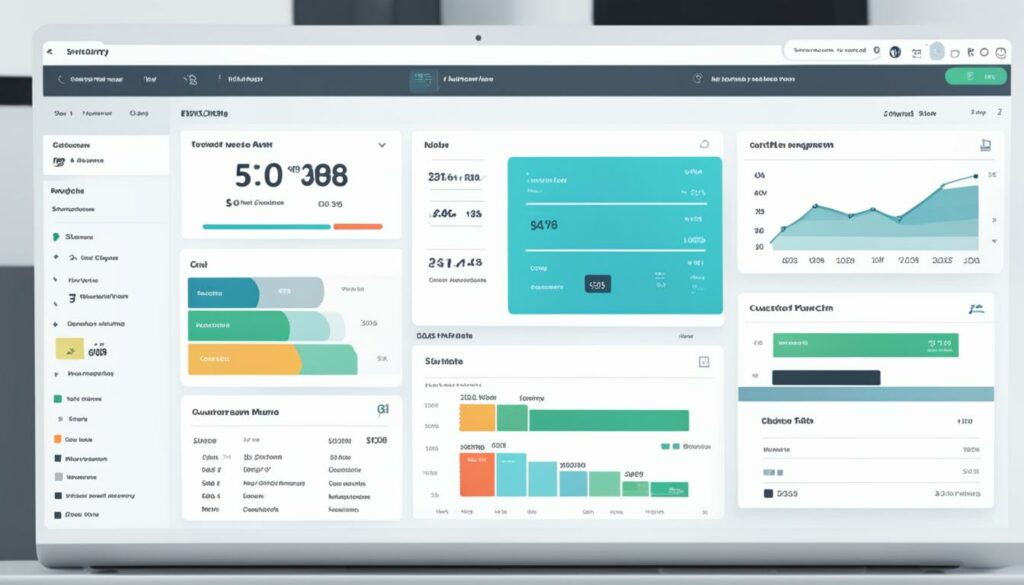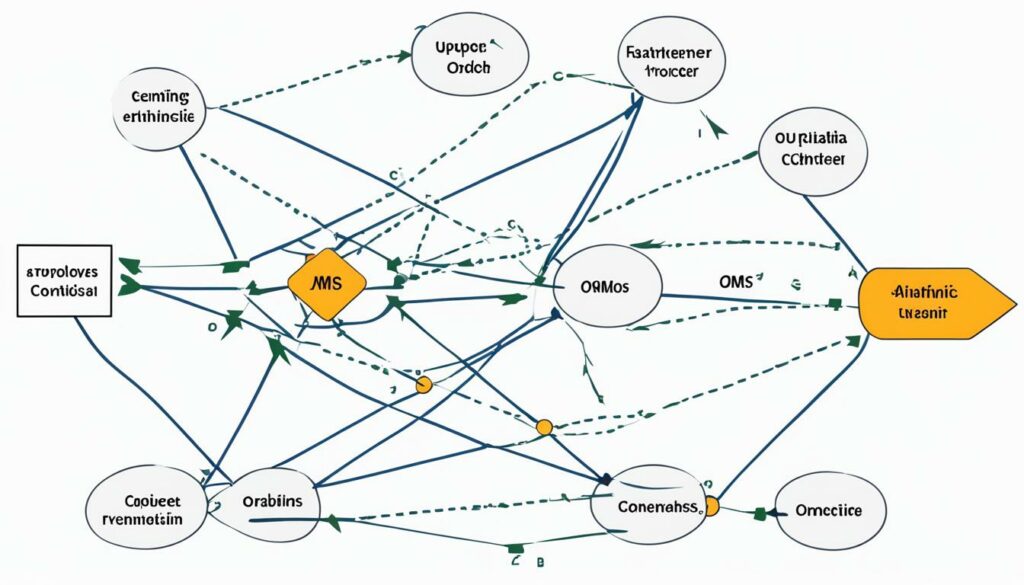An order management system (OMS) is a centralized platform that supports the entire sales process in ecommerce, from order creation to delivery and returns. It simplifies the buying process for customers and makes it easier for businesses to manage orders, inventory, fulfillment, and returns from multiple sales channels. The OMS helps automate key parts of the purchasing/fulfillment processes, such as order fulfillment, inventory monitoring, and tracking. It also provides valuable insights through analytics and reporting, allowing businesses to optimize their operations and improve efficiency. OMS platforms are crucial for meeting customer expectations and streamlining order management in the fast-growing ecommerce industry.
Key Takeaways:
- An order management system (OMS) is a centralized platform that supports the entire sales process in ecommerce.
- OMS simplifies the buying process for customers and makes it easier for businesses to manage orders, inventory, fulfillment, and returns.
- OMS automates key parts of the purchasing/fulfillment processes, providing valuable insights and allowing businesses to optimize their operations and improve efficiency.
OMS Importance and Benefits in Ecommerce
In the rapidly growing ecommerce industry, the importance of an Order Management System (OMS) cannot be overstated. OMS plays a crucial role in meeting customer expectations, streamlining operations, and driving business success. Let’s explore the advantages and benefits of using OMS in ecommerce.
Flexibility to Meet Customer Expectations
An OMS provides the flexibility that customers demand in the buying process. It allows customers to easily place orders, select convenient delivery options, and even choose to pick up products from physical stores. Additionally, OMS facilitates smooth returns and exchanges, ensuring a seamless customer experience.
Efficient Distributed Order Management
OMS enables businesses to efficiently manage orders from multiple sales channels and fulfillment locations. This distributed order management capability helps reduce shipping costs and improve order fulfillment time. By leveraging OMS, businesses can process orders from various regions, channels, and warehouses in a cost-effective and timely manner.
Operational Efficiency and Improved Customer Satisfaction
By automating order processing, fulfillment, and inventory management, an OMS significantly improves operational efficiency. It eliminates manual data entry errors, reduces order processing time, and optimizes inventory management. The result? Improved customer satisfaction, increased cash flow, and enhanced profitability.
Enhanced Visibility and Informed Decision-Making
An OMS provides businesses with a holistic view of their order status, inventory levels, and customer insights. With increased visibility into key metrics, businesses can make informed decisions, implement strategies to optimize their operations, and identify areas for improvement. Moreover, OMS offers in-depth analysis through advanced reporting and analytics, allowing businesses to fine-tune their order management processes.
| Advantages of OMS in Ecommerce | Benefits of Using OMS in Ecommerce |
|---|---|
|
|
By harnessing the power of an OMS, ecommerce businesses can achieve operational excellence, surpass customer expectations, and gain a competitive edge in the dynamic online retail landscape.

OMS Features and Working
When it comes to oms software for ecommerce, it is crucial to have the right set of features that streamline order management and enhance the customer experience. Here are some key features that an OMS should offer in the context of ecommerce:
- Order Tracking and Processing: An efficient OMS should provide real-time order tracking, allowing both businesses and customers to monitor the status of their orders. It should enable seamless order processing, ensuring accuracy and timely fulfillment.
- Inventory Management: Managing inventory is critical for ecommerce businesses. An OMS should offer robust inventory management capabilities, allowing businesses to monitor stock levels, prevent overselling, and optimize replenishment.
- Payment Processing: Integration with payment gateways and seamless payment processing is essential for a smooth buying experience. The OMS should support different payment methods and ensure secure transactions.
- Shipping Management and Carrier Integration: An OMS should provide shipping management tools that enable businesses to efficiently manage the shipping process, print shipping labels, and integrate with popular carriers for seamless order fulfillment.
- Returns and Refunds Management: Handling returns and refunds is an integral part of ecommerce. The OMS should offer features that streamline the returns process, provide automated refund processing, and maintain clear records of returned items.
The OMS works by integrating with various business systems to create a seamless flow of data and information. In the context of ecommerce, integration with the supply chain and customer relationship management (CRM) systems is particularly important.
“The integration of OMS with other business systems allows for seamless data flow and comprehensive insights.”
By integrating with the supply chain system, the OMS enables real-time visibility into available-to-promise (ATP) inventory. This ensures that customers are only shown products that are actually available, preventing disappointments and cancellations due to out-of-stock items.
Additionally, integrating OMS with the CRM system empowers businesses to provide personalized customer experiences, track customer interactions, and leverage data for targeted marketing campaigns.

| OMS Features | Description |
|---|---|
| Order Tracking and Processing | An efficient OMS should provide real-time order tracking and smooth order processing, ensuring accuracy and timely fulfillment. |
| Inventory Management | An OMS should offer robust inventory management capabilities to monitor stock levels and optimize replenishment. |
| Payment Processing | The OMS should support different payment methods and ensure secure transactions. |
| Shipping Management and Carrier Integration | An OMS should provide shipping management tools and integrate with popular carriers for seamless order fulfillment. |
| Returns and Refunds Management | The OMS should streamline the returns process, automate refund processing, and maintain clear records of returned items. |
Strategies to Improve OMS in Ecommerce
To enhance the effectiveness of an Order Management System (OMS) in ecommerce, businesses can implement several strategies. By optimizing inventory management, leveraging distributed order management (DOM) systems, integrating OMS with other business systems, and regularly analyzing OMS data, businesses can improve their order management processes and deliver a seamless customer experience.
1. Optimize Inventory Management
An OMS’s inventory management capabilities play a crucial role in ensuring accurate stock levels and preventing stockouts. By utilizing advanced features such as real-time data updates, data centralization, and true-up capabilities, businesses can improve inventory accuracy and streamline the fulfillment process. This optimization enables businesses to fulfill customer orders efficiently and avoid disappointing them with out-of-stock products.
2. Leverage Distributed Order Management (DOM) Systems
With the growth of omnichannel retail, businesses need to efficiently manage orders across various sales channels. Implementing a DOM system allows businesses to consolidate orders from multiple channels and fulfill them from different locations. This approach offers flexibility and cost-effectiveness in order fulfillment, improving customer satisfaction. Moreover, DOM systems enable businesses to configure changes to their systems and workflows self-service, reducing dependence on IT teams and speeding up responsiveness to customer demands.
3. Integrate OMS with Other Business Systems
For comprehensive insights and holistic operational control, integrating the OMS with other business systems such as enterprise resource planning (ERP) platforms is crucial. This integration allows for a seamless flow of data and information, improving visibility and enabling data-driven decision-making. By leveraging integrated systems, businesses can efficiently manage inventory, automating processes, and enhance operational efficiency.
4. Regularly Analyze OMS Data and Monitor KPIs
Continuous improvement is vital in ecommerce. To enhance order management processes, businesses should regularly analyze OMS data, monitor key performance indicators (KPIs), and proactively address inefficiencies. By understanding data trends, identifying bottlenecks, and implementing optimization measures, businesses can streamline their operations and provide a better customer experience.
Implementing these strategies will empower businesses to optimize their OMS in ecommerce, drive operational efficiency, and enhance the overall customer experience. By staying proactive and continuously improving their order management processes, businesses can position themselves for success in the competitive ecommerce landscape.
Customer Behavior and OMS in Ecommerce
Customer behavior is a crucial factor in the success of any ecommerce business. Understanding how customers interact with your online store and making their buying journey seamless is essential for driving sales and fostering loyalty. The order management system (OMS) plays a significant role in shaping the customer experience and influencing their purchasing decisions.
When customers shop online, they expect transparency and convenience throughout the entire order process. This includes access to real-time order tracking, receiving timely updates on their orders, and having a hassle-free returns and refunds process. An OMS enables businesses to meet these customer expectations by providing a streamlined order management process.
With an OMS in place, customers have visibility into their orders from start to finish. They can track the progress of their orders, ensuring they are aware of each step, from order creation to fulfillment and delivery. This transparency builds trust and confidence in the buying process, enhancing customer satisfaction and loyalty.
Additionally, an OMS simplifies the returns and refunds process for customers. It offers convenience and ease of use, allowing customers to initiate returns and receive refunds efficiently. A seamless returns process not only improves customer satisfaction but also encourages repeat purchases and fosters long-term customer relationships.
By leveraging the power of an OMS to create a positive buying experience, businesses can differentiate themselves in the highly competitive ecommerce landscape. Understanding and catering to customer behavior through an OMS improves customer satisfaction, builds trust, and drives repeat business.
“The effective use of an OMS within ecommerce can revolutionize the customer experience, leading to increased customer satisfaction, loyalty, and ultimately higher sales.”
With an OMS, businesses can gain insights into customer behavior, preferences, and buying patterns. These valuable insights can then be used to personalize marketing initiatives, optimize product offerings, and drive targeted promotions.
In summary, customer behavior plays a crucial role in ecommerce, shaping the success of online businesses. An OMS enables businesses to meet and exceed customer expectations by providing a streamlined order management process. By leveraging an OMS effectively, businesses can build trust, enhance customer satisfaction, and drive repeat business. Understanding customer behavior and leveraging the power of an OMS is crucial in staying competitive and thriving in the ecommerce industry.

Challenges and Considerations of OMS in Ecommerce
While OMS software offers numerous benefits in the ecommerce industry, there are also challenges and considerations that businesses need to take into account. One of the main challenges is the integration of the OMS with existing systems, such as customer relationship management (CRM), finance, and supply chain. Seamless integration is crucial for maximizing efficiency and providing excellent customer service.
When choosing an OMS, it is important to carefully consider the features and configuration options. Each business has unique needs, and the OMS should be able to align with those specific requirements. Additionally, the user interface of the OMS should be user-friendly and provide easy access to data and reports. This ensures that employees can navigate the system efficiently and make data-driven decisions.
Security and data access control are also vital considerations when implementing an OMS. As multiple employees may have access to the system, it is important to establish proper security protocols to protect sensitive data. Regular evaluation of the OMS’s performance and effectiveness is essential for identifying any missing features and addressing potential issues. Staying updated with technology advancements in the field of OMS can help businesses optimize their use of the system and stay ahead in the competitive ecommerce landscape.
In conclusion, while there are challenges and considerations involved in implementing an OMS in ecommerce, careful planning and consideration of integration, features, user interface, security, and regular evaluation can help businesses overcome these challenges and harness the full potential of an OMS to streamline their order management processes and enhance customer satisfaction.
FAQ
What is an OMS in ecommerce?
An OMS, or Order Management System, is a centralized platform that supports the entire sales process in ecommerce, from order creation to delivery and returns. It simplifies the buying process for customers and makes it easier for businesses to manage orders, inventory, fulfillment, and returns from multiple sales channels.
Why is an OMS important in ecommerce?
An OMS is important in ecommerce because it helps meet customer expectations, enables distributed order management, and enhances operational efficiency. It provides flexibility in ordering and fulfillment, automates key processes, and improves customer satisfaction, cash flow, and profitability.
What are the benefits of using an OMS in ecommerce?
The benefits of using an OMS in ecommerce include tighter inventory management, reduced data entry, increased visibility into order status, enhanced analysis for informed decision-making, and improved overall efficiency and customer experience.
What are the key features of OMS software for ecommerce?
The key features of OMS software for ecommerce include order tracking and processing, inventory management, payment processing, shipping management and integration with carriers, and returns and refunds management.
How does an OMS work in ecommerce?
An OMS works by providing real-time visibility into available-to-promise (ATP) inventory, facilitating fulfillment through robust order capture, validation, pick-pack-ship functionality, and managing the payments and returns process. Integration with other business systems allows for seamless data flow and comprehensive insights.
What strategies can be implemented to improve OMS in ecommerce?
Strategies to improve OMS in ecommerce include optimizing inventory management, leveraging distributed order management (DOM) systems, integrating OMS with other business systems, and regularly analyzing data to address inefficiencies and drive continuous improvement.
How does customer behavior impact OMS in ecommerce?
Customer behavior plays a critical role in ecommerce, and an OMS has a significant impact on the customer experience. A streamlined order management process, enabled by an OMS, improves customer satisfaction and loyalty by providing transparency in order tracking, real-time updates, and convenience in returns and refunds.
What challenges and considerations should be kept in mind when using an OMS in ecommerce?
When using an OMS in ecommerce, it is important to consider integration with existing systems, choose the right features and configuration options, ensure a user-friendly interface, and address security and data access control. Regular evaluation and staying updated with technology advancements are also important for optimizing the use of OMS in ecommerce.
